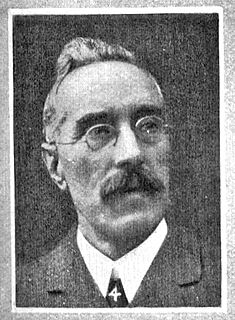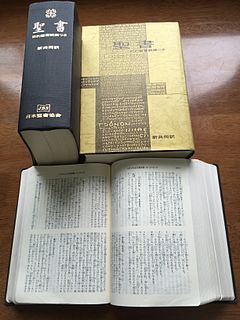Related Research Articles

Walter Henry Medhurst, was an English Congregationalist missionary to China, born in London and educated at St Paul's School. He was one of the early translators of the Bible into Chinese language editions.

Karl Friedrich August Gützlaff, anglicised as Charles Gutzlaff, was a German Lutheran missionary to the Far East, notable as one of the first Protestant missionaries in Bangkok, Thailand (1828) and in Korea (1832). He was also the first Lutheran missionary to China. He was a magistrate in Ningpo and Chusan and the second Chinese Secretary of the British administration in Hong Kong.
The Chinese Union Version (CUV) is the predominant translation of the Bible into Chinese used by Chinese Protestants, first published in 1919. The text is now available online.

John Robert Morrison was a British interpreter and colonial official in China. Born in Macau, his father was Robert Morrison, the first Protestant missionary in China. After his father's death in 1834, Morrison replaced him as Chinese Secretary and Interpreter to the Superintendents of British Trade in China. In 1843, he was appointed as Acting Colonial Secretary of Hong Kong and a member of the Executive and Legislative Councils, but died eight days later in Hong Kong from fever.

Frederick William Baller was a British Protestant Christian missionary to China, Chinese linguist, translator, educator and sinologist.
William Charles Milne(美魏茶 born April 22, 1815, died May 25, 1863) was a missionary to China in the 19th century. He was the son of missionary William Milne.

Elijah Coleman Bridgman was the first American Protestant Christian missionary appointed to China. He served with the American Board of Commissioners for Foreign Missions. One of the first few Protestant missionaries to arrive in China prior to the First Opium War, Bridgman was a pioneering scholar and cultural intermediary, and laid the foundations for American sinology. His work shaped the development of early Sino-American relations. He contributed immensely to America's knowledge and understanding of Chinese civilization through his extensive writings on the country's history and culture in publications such as The Chinese Repository — the world's first major journal of sinology, which he began and edited. Bridgman became America's first "China expert." Among his other works was the first Chinese language history of the United States: "Short Account of the United States of America" and "The East-West Monthly Examiner". As a translator he contributed greatly to the formulation of America's first treaty with the Chinese government under the Qing Dynasty.
The Protestant Episcopal Church Mission was a Christian missionary initiative of the Episcopal Church that was involved in sending and providing financial support to lay and ordained mission workers in growing population centers in the west of the United States as well as overseas in China, Liberia and Japan during the second half of the 19th Century.
Scottish Bible Society (SBS), founded in 1809 as the Edinburgh Bible Society, amalgamated in 1861 with the Glasgow Bible Society to form the National Bible Society of Scotland, is a Scottish Christian charity that exists to make the Bible available throughout the world.

Bible translations into Chinese include translations of the whole or parts of the Bible into any of the levels and varieties of the Chinese language. The first translations may have been made as early as the 7th century AD, but the first printed translations appeared only in the nineteenth century. Progress on a modern translation was encumbered by denominational rivalries, theological clashes, linguistic disputes, and practical challenges at least until the publication of the Protestant Chinese Union Version in 1919, which became the basis of standard versions in use today.
Michael Simpson Culbertson was an American Presbyterian clergyman, missionary to China, academic and author.
Although Christianity became the state religion of Ethiopia in the 4th century, and the Bible was first translated into Ge'ez at about that time, only in the last two centuries have there appeared translations of the Bible into Amharic.

There are two main translations of the Bible into Japanese widely in use today—the New Interconfessional Version and the New Japanese Bible. New Interconfessional Translation Version is published by the Japan Bible Society and the New Japanese Bible is published by Inochinokotoba-sha(いのちのことば社). There are with different translation goals. The New Japanese Version aims to be used as a literal translation using modern Japanese while the New Interconfessional Version aims to be ecumenically used by all Christian denominations and must therefore conform to various theologies. Protestant Evangelicals most often use the New Japanese Version, but the New Interconfessional Version is the most widely distributed and the one used by the Catholic Church, the United Church of Christ, Lutheran Church factions and many Anglicans in Japan.
The earliest preserved translation of the Bible into the Mongolian language dates to 1827, but there is a written record of what may perhaps have been a translation existing as early as 1305. Since 1827, numerous other translations have been made.
The earliest known Christian texts in Old Uyghur are known from manuscript fragments uncovered in the Turfan oasis. There are approximately fifty fragments written in Old Uyghur. An early Uyghur translation of the New Testament and the Psalms may have been done in the 14th century by Giovanni da Montecorvino, papal envoy to the Mongols who became Roman Catholic archbishop of Khanbaliq in 1307.

The history of Bible translations into the Tamil language commences with the arrival of Bartholomä
The Bible, or portions of it, have been translated into over 1,000 languages of Africa. Many of these are indexed by the Forum of Bible Agencies, Find.Bible site and available online in text and audio form, as print on demand versions, or through churches and book sellers. This effort continues. Not all are (yet) listed below.
The Hakka Bible: Today's Taiwan Hakka Version (TTHV), is the most recent revised Hakka language translation of the Bible used by Hakka Protestants in Taiwan and overseas Hakka communities. Work on the translation commenced in 1984 with the TTHV New Testament & Psalms completed in 1993, Proverbs was published separately in 1995. The entire Bible was made available on April 11, 2012 at the Presbyterian Church in Taiwan's annual General Assembly meeting. An ecumenical dedication and thanksgiving ceremony was held on April 22, 2012 at the National Chiao Tung University in Hsinchu with over 1,200 Hakka Christians in attendance.

Bible translations into Malay include translations of the whole or parts of the Bible into any of the levels and varieties of the Malay language. Publication of early or partial translations began as early as the seventeenth century although there is evidence that the Jesuit missionary, Francis Xavier, translated religious texts that included Bible verses into Malay as early as the sixteenth century.
References
| Chinese Wikisource has original text related to this article: |
- 1 2 Zetzsche, Jost Oliver. Bible in China: The History of the Union Version or the Culmination of Protestant Missionary Bible Translation in China. Sankt Augustin: Monumenta Serica. pp. 82–107. ISBN 978-1-351-57397-9.
- 1 2 3 Wylie, Alexander (1889). "The Bible in China: A Record of Various Translations of the Holy Scriptures". In Foster, Arnold (ed.). Christian Progress in China: Gleanings from the Writings and Speeches of Many Workers. London: Religious Tract Society. pp. 29–46.
- ↑ Hanan, Patrick (2003-01-01). "The Bible as Chinese Literature: Medhurst, Wang Tao, and the Delegates' Version". Harvard Journal of Asiatic Studies. 63 (1): 197–239. doi:10.2307/25066695. JSTOR 25066695.
- ↑ Mak, George Kam Wah (2017). Protestant Bible Translation and Mandarin as the National Language of China. Leiden: Brill. pp. 9–10. ISBN 978-90-04-31630-0.
- ↑ Bays, Daniel H. (2012). A New History of Christianity in China. Malden, MA: Wiley & Blackwell. p. 50. ISBN 978-1-4443-4284-0.